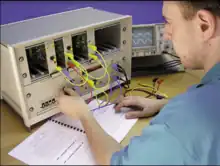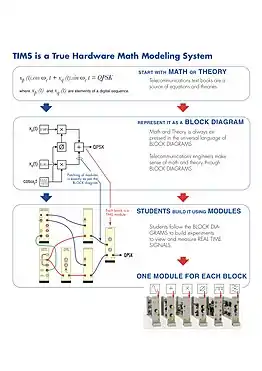 EMONA TIMS301 with student | |
| Type | Telecommunications Training Device |
|---|---|
| Inventor | Tim Hooper |
| Inception | 1971 |
| Manufacturer | Emona |
| Available | Yes |
| Website | https://www.emona-tims.com/ |
TIMS, or Telecommunication Instructional Modeling System, is an electronic device invented by Tim Hooper and developed by Australian engineering company Emona Instruments that is used as a telecommunications trainer in educational settings and universities.[1][2][3]
History
TIMS was designed at the University of New South Wales by Tim Hooper in 1971. It was developed to run student experiments for electrical engineering communications courses.[4][5] Hooper’s concept was developed into the current TIMS model in the late 1980s.[6][7] In 1986, the project won a competition organized by Electronics Australia for development work using the Texas Instruments TMS320.[8][9] Emona Instruments also received an award for TIMS at the fifth Secrets of Australian ICT Innovation Competition.[9]
Methodology

TIMS uses a block diagram-based interface for experiments in the classroom. It can model mathematical equations to simulate electric signals, or it can use block diagrams to simulate telecommunications systems.[4][7][10] It uses a different hardware card to represent functions for each block of the diagram.[11]
TIMS consists of a server, a chassis, and boards that can emulate the configurations of a telecommunications system.[12] It uses electronic circuits as modules to simulate the components of analog and digital communications systems.[13][14] The modules can perform different functions such as signal generation, signal processing, signal measurement, and digital signal processing.[10][13]
Variants
The block diagram approach to modeling the mathematics of a telecommunication system has also been ported across to other domains.[15][16]
Simulation
Where the blocks are patched together onscreen to mimic the hardware implementation but with a simulation engine (known as TutorTIMS).[15][16]
Remote access
It can be used by multiple students at once across the internet or LAN via a browser based client screen. This utilises a statistical time division multiplexing architecture in the control unit. The method is applied both to Telecommunications and Electronics Laboratories (known as netCIRCUITlabs).[15][16]
V References
- ↑ Sarfaraz, Maysam (2011-05-01). Educational Applications of Partial Reconfiguration of FPGAs (Master's thesis). University of Tennessee at Chattanooga.
- ↑ Silva, Mário Marques da (2018-09-03). Cable and Wireless Networks: Theory and Practice. CRC Press. ISBN 978-1-4987-5154-4.
- ↑ ASEE Annual Conference Proceedings. American Society for Engineering Education. 2004.
- 1 2 "Using Telecommunication Instructional Modelling System (TIMS) in Communications Systems Course" (PDF). American Association for Engineering Education. Paper ID #18924. 2017.
- ↑ Hooper, T. L. (1973-08-01). "Telecommunications Systems Modeling in the Laboratory". IEEE Transactions on Education. 16 (3): 148–152. Bibcode:1973ITEdu..16..148H. doi:10.1109/TE.1973.4320828. ISSN 1557-9638.
- ↑ "NJIT- EE495 : Introduction to Modeling with TIMS". web.njit.edu. Retrieved 2021-08-13.
- 1 2 Breznik, Alfred (2004-01-30). "Hands-on learning system for Wireless laboratory courses" (PDF). Proceedings of the 2004 American Society for Engineering Education Annual Conference & Exposition: 9.658.1–9.658.5.
- ↑ Wierer, Jay; Chandler, Edward (June 2011). "Analog and Digital Communications Laboratory Experiments Using Emona TIMS". 2011 ASEE Annual Conference & Exposition Proceedings: 22.203.1–22.203.12. doi:10.18260/1-2--17484. S2CID 54537460.
- 1 2 "Sticisce avstralskih Slovencev - Slovenian network in Australia". www.glasslovenije.com.au. Retrieved 2021-07-08.
- 1 2 Breznik, Alfred (2004-10-01). TIMS-301 USER MANUAL (PDF). Emona Instruments Pty Ltd.
- ↑ Purani, Abhilash M. (2010-04-23). An Evaluation of Low Cost FPGA-Based Software Defined Radios for Education and Research (Master's thesis). University of Tennessee at Chattanooga.
- ↑ Sandoval, Jose R Santamaria (2020-04-01). "Application of the EMONA TIMS platform for the Telecomunications Engineering career at UNED Costa Rica". Engineering Education.
- 1 2 Khan, Muhammad Ajmal (2018-06-01). "Enhancing Students' Lab Experiences using Simulink-based Pre-Labsof Corresponding Hardware-based Labs" (PDF). Proceedings of the 2018 ASEE North Central Section Conference.
- ↑ Sakovičs, Ričards (2019). Digital-to-analog and Analog-to-digital Converter Operational Research (Bachelor's thesis). Riga Technical University.
- 1 2 3 Jeřábek, Josef (2008-11-02). Optimalizace telekomunikačního výukového prostředí (Master's thesis). Vysoké učení technické v Brně.
- 1 2 3 Veettil, Binesh Puthen; Payne, David; Bagnall, Darren; Cetin, Ediz (2020-12-01). "Quantifying and Improving Student Engagement with Remotely Accessible Laboratory Project Hardware (RALPH)". 2020 IEEE International Conference on Teaching, Assessment, and Learning for Engineering (TALE). pp. 714–718. doi:10.1109/TALE48869.2020.9368478. ISBN 978-1-7281-6942-2. S2CID 229209526.